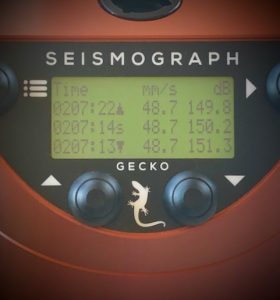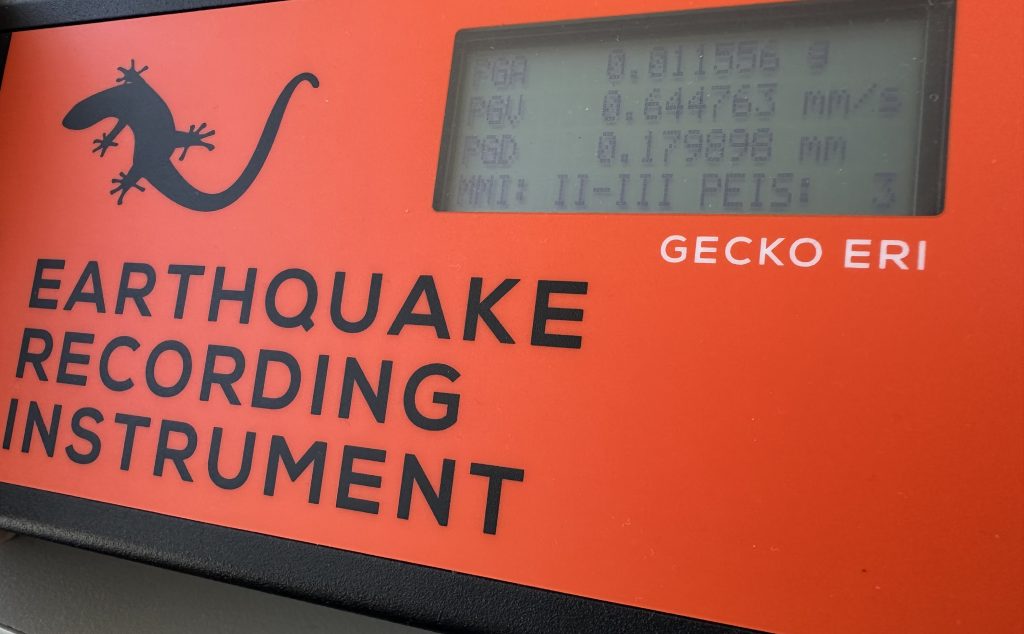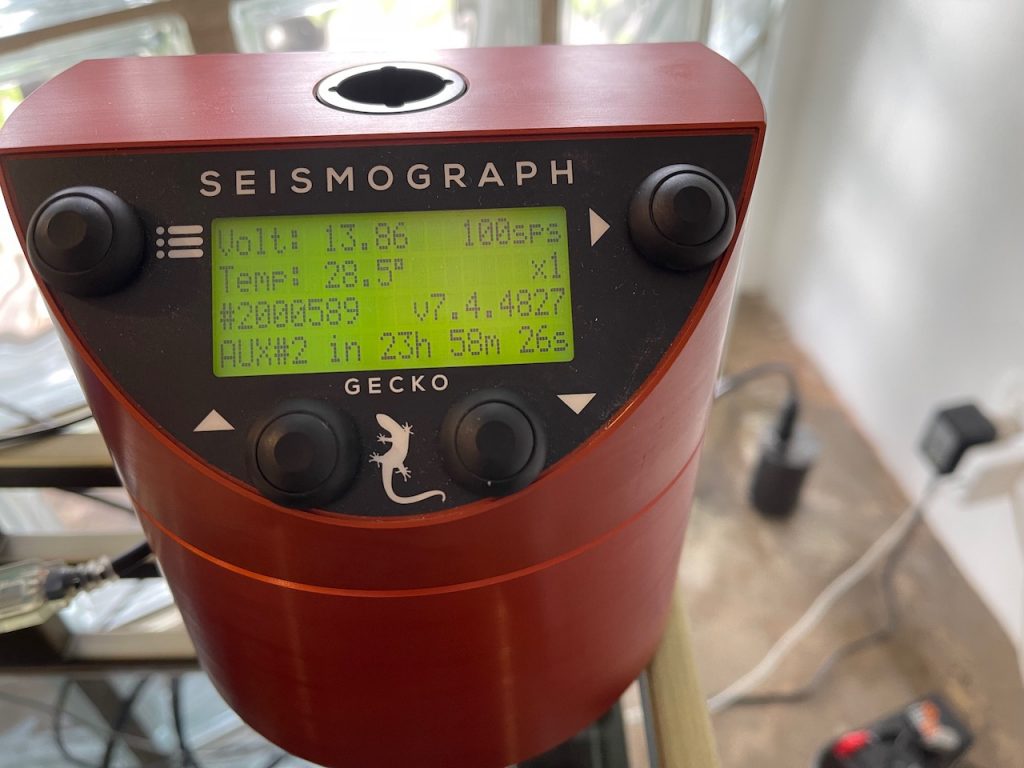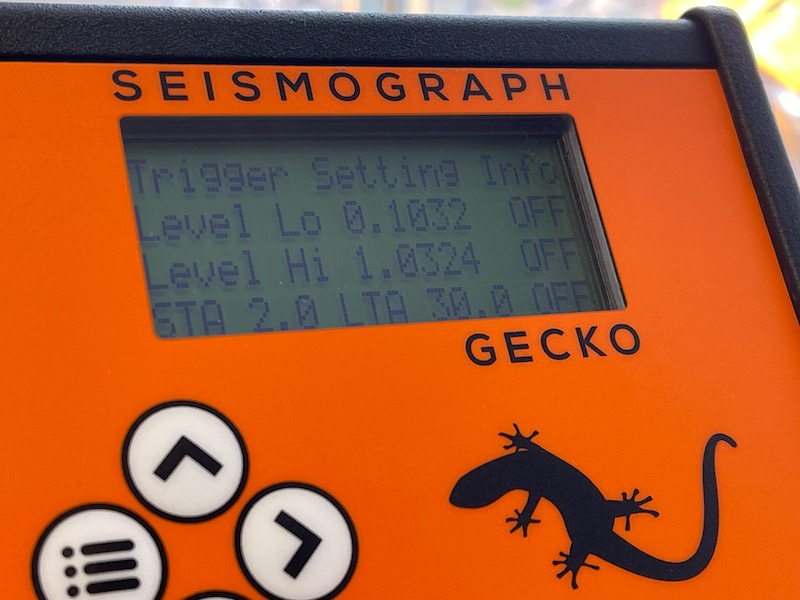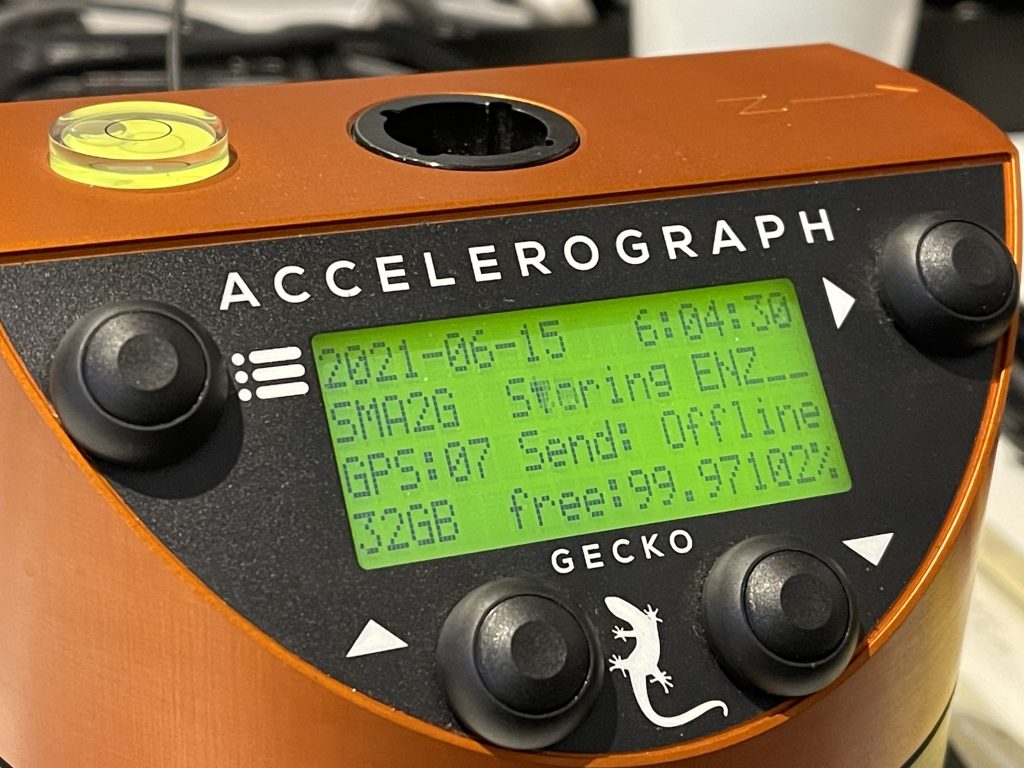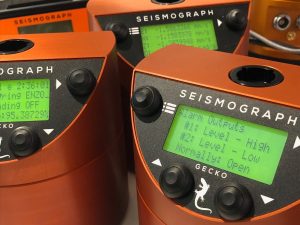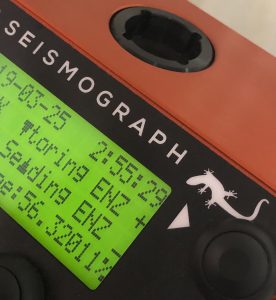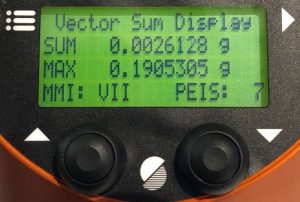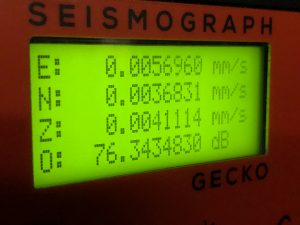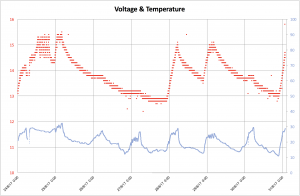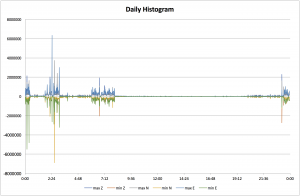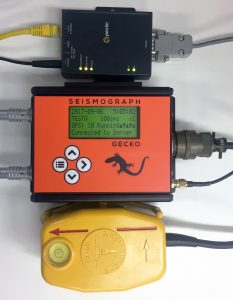The latest Gecko firmware available for download here.
Version 7.8 – a critical update as it monitors for more SD error conditions that in some cases could cause the Gecko to be unable to create new files, resulting in empty folders. Gecko v7.8 introduces new data telemetry modes, including periodic ASCII output of ground motion and health information to the RS232 serial port, and the ability to store data in one-hour long files (instead of one-minute files) when telemetry is disabled. The Gecko also now calculates PGA, PGV and PGD in real time when you have an acceleration or velocity sensor on the 3D sensor input, and log files are now stored by day in a separate folder.
Version 7.7 fixed an issue where the triggering was active at startup and could activate an alarm output before a sensor had been zero-level-corrected. Triggering is disabled for 40 seconds after startup to allow various types of sensors to complete their self-test startup routines before the signals are analysed by the triggering algorithms.
Version 7.6. We have been working hard to find the source of a seemingly random bug that would cause SD card files and directories to be hidden. The data is not lost, but it would require a potentially lengthy data recovery process. Our investigation revealed an issue in the underlying SD card file system, so we have added new code to detect malformed file/folder addresses. We continue to monitor this issue and encourage user feedback if these or similar issues persist.
A new feature in v7.6 is the ability to reformat a FAT32 SD card through the LCD/keypad user interface. We have also fixed a bug with the Level Trigger setting information display, and a bug that occasionally caused a histogram entry to fail. Finally, we have added the ability to disable the creation of histogram files entirely. Histograms will be disabled by default in new Gecko recorders, but your existing histogram logging interval setting will remain unchanged after the update.
Version 7.5 fixed a bug where the GPS location was dispalyed incorrectly on the bottom line of the voltage/temperature screen. The stored GPS location was unaffected and was stored correctly.
Version 7.4 adds new features to aid field deployment, and utilises more of your storage memory. Sensor port pins N, P and R have previously been used for sensor control, each pulling low for 5 seconds when activated. Users now have additional control over pin P, with the ability to set it to active high (+5V) or low (GND), and to start a 24-hour timer to activate this auxiliary control line. If deploying a remote sensor that needs to settle before initiating a mass centring routine, connecting the mass centre control line to pin P and starting the 24-hour countdown avoids a return visit to re-centre the sensor. As SD card capacities increase, the need to reserve some working space has allowed us to increase the size of the ring buffer from 95% to 99%, so depending on the sample rate you’ll get many extra hours, days, or weeks of recording time. An updated user manual is available that details these new features.
Version 7.3 brought additional state-of-health intervals: 2-second and 5-second logging (with fewer columns for smaller file size) in addition to the original 1 minute interval which sees the return of axial peak values. The Trigger List and Trigger Info screens have also been improved to reflect the status of those processes. All new Geckos now have a unique station code related to their serial number, and an “SS” network code by default.
Version 7.2 brought the option to store state-of-health parameters once per second (was previously fixed to once per minute), storing a reduced number of parameters, with improved histogram file handling to reduce file write errors.
Version 7.1 fixed a bug that could cause an instrument reboot when a keypress turned the LCD backlight before an internal operation completed. It also brings staged power-up control to early 2022 digitisers that used alternative higher-consumption components necessary due to the COVID-related global semiconductor shortage.
Version 7.0 introduced ADC value error detection and correction, eliminating single-sample spikes (that appear as ringing spikes for decimated sample rates), reducing the incidence of false triggers and peak particle values.
Version 6.9 creates a new .ss file after power up as soon as the GPS location is attained, useful for portable survey applications where the recorder is moved every few minutes.
Version 6.8 implemented a new digitiser synchronisation routine for improved startup reliability, and added an extra info screen in the right-button loop to display the trigger setting summary. The next-to-last info screen now shows recent trigger peaks to more decimal places where possible.
Version 6.7 introduced a delay in the trigger/alarm process to allow the sensor signal offset to be corrected at startup, and also fixes a bug related to external sensor power control via eqServer and Streams. We also updated the sensor list with several new models and updated default settings for geophones.
Version 6.6 added a decimal place to the supply voltage reported during data telemetry. It also introduced a feature for upcoming versions of Streams and eqServer to know when a setting was last changed in the Gecko to reduce the number of parameter requests sent by those applications.
Version 6.5 fixed a bug that disabled the calibration signal generation in v6.4. It also changed the telemetry status message on the Home Screen to minimise confusion with the GPS status, and also introduced a number of new third-party sensors to the preset list.
Version 6.4 ignored alarm output triggering at Gecko startup, fixed STA/LTA calculation, added 1D channel scaling correctly for -HR models, reduced lag in supply voltage display, and fixed a bug that could cause a reboot when LCD is manually woken up after some time.
Version 6.3 improved handling of the ring buffer, where old data is deleted when less than 5% of the SD card’s storage remains. Old corrupt files could interrupt the deletion routine, but now the deletion of corrupted file-folders will be skipped. A minor bug where waking the display backlight could cause a reboot has been addressed. This firmware also supports new models, with Gecko Prism and SMA-HR models now adding a ±2.5V input for a 1D sensor.
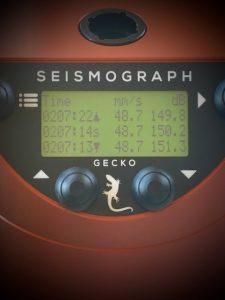
Version 6.2 completely overhauled telemetry of triggered data for networks. When any station connected to your data server triggers, an immediate message is broadcast to all connected Gecko recorder to start streaming all stored channels of data immediately. This includes however many seconds of data are in the pre-trigger buffer. A new trigger list viewer is available on the LCD, showing the peak 3D and 1D motion. This version also fixes some bugs related to alarm activation when multiple Level Trigger processes we active, and drift-compensated sensors are now auto-zeroed 40 seconds after startup.
Version 6.1 introduced a thermal drift compensation option for sensors, replacing the auto-zero delay setting. Users can still manually set the zero level using the LCD/buttons, but now also clear the zero offset manually.
Version 6.0 added support for our updated “Pro” model sensors and improved data sampling. Specifically, the implementation of simpler decimation and fewer filter coefficients means that the sample rate 40sps has been replaced with 50sps, and that 1600sps is now redundant. Performance improvements are related to data telemetry with more intelligent handling of settings changes, and the SD card free space limit has been increased to 5% to allow for improved memory management.
Gecko firmware version 5.0 was a major release and a required update for all Gecko recorders that addresses a condition where the SD card’s FAT file system could become corrupted, effectively hiding recorded data files and folders. Improving the SD card file handling to address this problem also resulted in improved reliability at higher sample rates and in data telemetry. v5.0 also brought new features including a second Level Trigger (now you can set a “High” and a “Low” level trigger) and the ability to set the alarm output to be normally closed (opened when triggered) if required, and after upgrading you will be able to remotely upgrade to future versions via Live Stream or eqServer.
Gecko firmware version 4.3 fixed a bug where the Gecko may loop at startup if the sample rate was set to 4000sps, improved compatibility with Live Stream, and tweaked the user interface for improved status feedback and readability.
Version 4.2 centred around improved speed and stability of data telemetry and communication with the Live Stream software for displaying data on a PC. It also squashed some bugs related to storing of the STA and high pass filter settings.
Version 4.1 was a required update for users of IEPE sensors to ensure that the sufficient voltage is provided to the sensor. It also introduces the ability to activate a high pass filter (required for IEPE sensors) which removes any DC voltage offset from the input signal.
Version 4.0 was a major upgrade to the firmware and user interface, so we suggest you download and read the updated user manual to learn all about the new features of the Gecko operating system. Viewing the recorder status and realtime data was quicker, and there is much more flexibility with channel setup on 3D and 1D sensor inputs. Unused channels can be turned off completely to save storage, and we introduced the ability to store and/or stream the vector sum of the 3D sensor.
The home screen now displays which channels are being stored to the SD card, and which are being streamed to a remote PC. The status line on the home screen has been expanded to several screens to see more information at a glance. Another useful feature of v4.0 is the ability to customise the sensitivity of each channel according to the sensor supplier’s calibration certificate.
The upgrade process is as simple as ever: copy the Rasbora.bin upgrade file onto your Gecko’s SD card, insert the SD into your Gecko and then apply power. As version 4.0 introduces a number of new settings, be sure to check all of your recorder’s settings after the upgrade. We recommended performing this upgrade via SD card, not remotely via Live Stream or eqServer as the “Channels to Send” settings structure may change your telemetry settings.
Gecko v3.3 addressed a directory bug in the base code that became more obvious after the file system upgrade in v3.2, which also brought a new realtime vector sum display that holds the highest peak signal until reset. 4-channel recorders with a microphone attached to the 4th channel also show the peak pressure recorded. When used as an accelerograph, an estimate of the Modified Mercalli Intensity (MMI) and the equivalent Philippine Earthquake Intensity Scale (PEIS) values are also displayed. The MMI/PEIS estimate is also displayed on the Level trigger setting screen. The updated file system allowed instant mounting of an inserted SD card, and the ability to unmount an SD card without stopping data telemetry.
Gecko firmware version 3.1 featured faster access to data with more “right arrow” information lines and more “up arrow” realtime data pages, and introduced support of the 4th channel available on mid-2018 Gecko Compact and Rugged recorders. Other changes included simpler sensor selection, vector peak Level triggering, and improvements to our implementation of MiniSEED data format.
To complement the new Gecko firmware, our free waveform analysis software has also been updated with a new component rotation feature and the ability to customise the magnitude estimation formula. Download the latest version of Waves here.
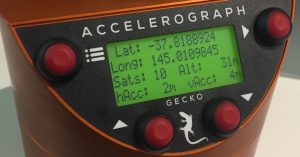
Firmware v2.9 brought improved reliability to remote firmware uploads, addressed a bug where the “Stop Sampling” function had no effect, and fixed incorrect channel labelling in Histogram and Trigger log files. Version 2.8 was a major under-the-hood tune-up of the firmware that addresses a number of bugs and improves telemetry efficiency and MiniSEED data compatibility.
Version 2.5 brought improved reliability for the optional Telit 3G modem, while v2.4 introduced many new features discussed below, support for remote firmware upgrades, remote Gecko configuration via the Live Stream app and eqServer, performance improvements and bug fixes.
The Histogram feature creates a daily CSV file on the SD card, with data logged every minute. The file can be easily imported into Excel or other graphing packages. The CSV file stores the maximum and minimum signal values for each channel from the previous minute, the supply voltage, internal temperature, latitude, longitude, altitude, horizontal and vertical GPS accuracy, and the clock crystal information.
By plotting the peak signal values you can quickly visualise a day of monitoring activity, which is particularly useful for blast monitoring applications.
When a Gecko is connected to a computer running Kelunji Hub (included in the free Windows/Linux Live Stream app and on eqServer) via Ethernet connection or cellular modem, in addition to continuous data streaming we now have a “Triggered Only” mode that just sends instantaneous trigger packets, suited to EEW (earthquake early warning) applications. Kelunji Hub can immediately generate an alarm, then request waveform data from the trigger time from all connected Gecko recorders for further analysis.
You can now also save your Gecko configuration file and then load that configuration file into another Gecko, which is particularly useful when pre-configuring large numbers of identical instruments for a deployment. Don’t forget to change each station code!
Download the updated user manual from our documentation resource library and get in touch if you have any questions or feedback.


